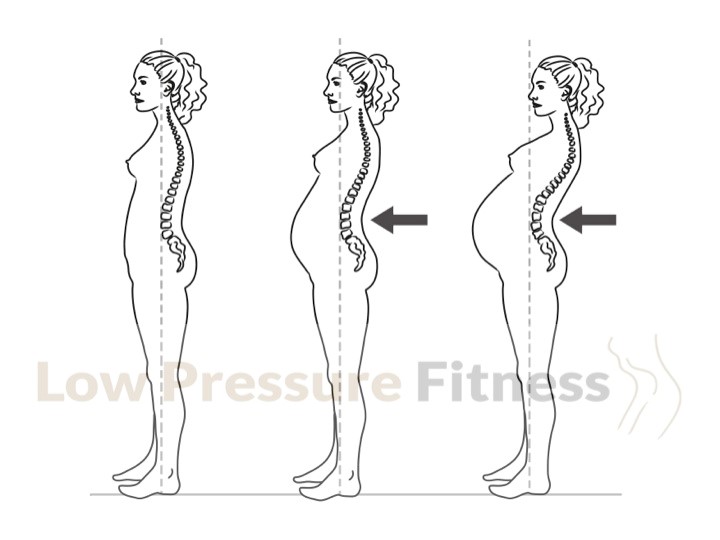Unfortunately, lumbopelvic pain is too common during pregnancy. Around 45% of women experience lumbopelvic pain during pregnancy and 25% of women continue to suffer postpartum,. So…almost 50% of pregnant women experience low back pain!
Pain usually appears in the lumbar region or the front of the pelvis, due in part to changes in the stability of the pelvis as well as muscular and ligamentous tissues. Proper posture can influence the postural tension of the back muscles, known as “antigravitational muscles”. When there is a deficiency or weakness in the back musculature, along with other risk factors such as obesity and physical inactivity, long-term postural and structural dysfunctions may appear. Pregnancy related low back pain, also known as back pain or sciatica, is located in the lower back, sides of the sacrum, the buttocks and even down the back of the thigh extending below the knees. Pregnancy related low back pain can affect one or both sides of the back and limbs. Usually it´s aggravated by standing, walking, movements while you sleeping, tilting the trunk, or lifting objects,. So awareness and early prevention are the best solutions to fight pregnancy related low back pain.
Why low back pain occurs during pregnancy?
Back pain etiology is linked to the physiological, anatomical, and mechanical changes which take place during pregnancy. Normal physiological changes during pregnancy affect the spine. They may contribute to the onset of back pain during pregnancy and possibly postpartum. The most characteristic changes are the following: posture adopted by women during pregnancy; total body water content; the endocrine system and vascular alterations during pregnancy.
- Postural Changes. There are noticeable postural changes throughout the nine months of pregnancy. These are characterized by increased lumbar lordosis. Hyperlordosis or excessive increase in the curvature of the spine is related to the contracture of the lumbar muscles which are forced to work harder, triggering pain in this area that can sometimes radiate down the legs. Most of the weight gained during pregnancy is concentrated at the bottom of the pelvis along with increased abdominal volume. Thus, a tendency to tilt your body forward would occur, which tends to compensate pregnant unconsciously with a rearward position of the upper body above the pelvis, restoring its center of gravity, but increasing the lumbar lordosis which can contribute to the development of low back pain.
- Total body water content. The body water content increases similarly in both primiparous and multiparous, by an average of 8.5 liters. This fluid retention, particularly at the connective tissue of the spine and pelvis, increases the laxity of these joints, which could contribute to the genesis of pain.
- Endocrinological changes. The effects of fluid retention just mentioned is enhanced by hormonal changes during pregnancy, particularly the effect of the hormone relaxin which increases laxity of the sacroiliac joints, symphysis pubis and cervix. This laxity, which is necessary to accommodate the growing fetus and facilitate childbirth, could also cause bloating and increased range of motion of the sacroiliac joints and symphysis, which can be a cause of lumbar pain. Also, serum levels of reproductive hormones and procollagen have been associated with the onset of pelvic pain in late pregnancy.
- Vascular changes. Up to 67% of women report low back pain during the second half of pregnancy. It is often a consequence of the combined fluid overload with obstruction of the inferior vena cava by the enlarged uterus, which could, in turn, result in congestion of the venous system ultimately leading to the onset of back pain, according to specialized literature hypothesis.
Scientific research links previous lumbar pain, stressful job or lumbopelvic pain related to previous work to a higher prevalence of low back pain during pregnancy. Even though, other important risk factors to take in account are:
- Weight gain over medical recommendations, which forces the lumbar muscles to make an extra effort, increasing the risk of contractures.
- The relaxation of the abdominal muscles: abdominal diastasis and the enlargement of the abdomen increases the physiological lumbar curve of the pregnant woman. But also the deep abdominal muscles (obliques and transversus abdominis) lose their competence and tone. To avoid this, it is essential to learn to exercise the deep abdominal muscles and implement safe core abdominal training before and during pregnancy.
- Glute weakness. Glutes are related with pelvic floor health and spinal functionality. In the case of pregnant woman, an appropiate gluteal muscle strenght, will help stabilize lumbopelvic region, working synergistically with the lumbar spine and the pelvic floor.
- Sedentary lifestyle: unless the pregnant woman is told by a health care provider to avoid exercise, regular physical activity is recommended for better postural control, correct biomechanical joint and a toned muscles, to suit their own changes pregnancy and childbirth reach the day in the best possible conditions.
Exercise better than paracetamol.
For all the above risk factors, the best preventive medicine will always be exercise. Its too extended between some health professionals recommend analgesics like paracetalmol or complete rest to recover back pain. But its well known that prolonged bed rest promotes weight gain which further deteriorates physical condition. Also, taking painkillers may not be the best solution in the short and long term.
Engaging in a regular program of exercise like Low Pressure Fitness before, during and after pregnancy to an excellent choice to reduce the risk of low back pain. It is recommended to tone the core muscles and for postural re-education, two principal targets for fitness pregnancy workouts. Furthermore, Low Pressure Fitness as a global program will train glutes and pelvic floor, essential musculature that provides stability to the pelvis. Specialized trainers or physiotherapists will provide the best advise and training programs before, during and after pregnancy.

